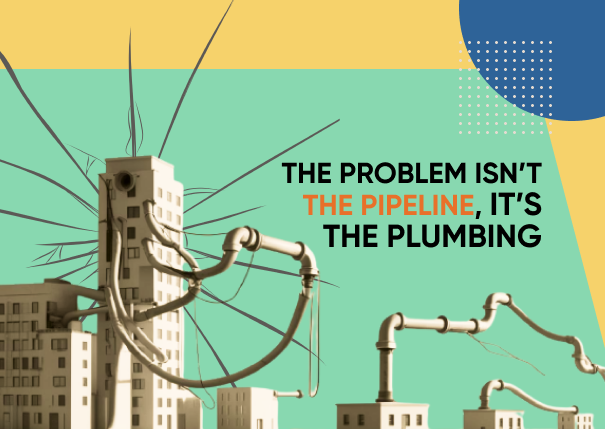Introduction
There’s a familiar refrain in institutional circles when asked why more capital isn’t flowing to diverse or emerging real estate operators: “We just don’t see enough pipeline.”
It’s a safe answer. A seemingly objective way to deflect responsibility. But it’s also misleading. The idea that there is a lack of qualified, compelling, or investable projects being sourced by this cohort isn’t just outdated—it was never entirely true.
The real issue isn’t the pipeline. It’s the plumbing.
The Reality: Projects Are Out There—Capital Isn’t
Across the country, there are hundreds of high-potential projects being led by small and emerging developers who are deeply rooted in the communities they serve. These include developers from backgrounds historically excluded from institutional capital—minority-led, women-led, veteran-owned enterprises, and first-time fund managers.
What they often lack isn’t vision, discipline, or community insight—it’s capital access. Specifically, the flexible, early-stage capital and institutional relationships that enable growth and resilience. Instead, they’re left to navigate a fragmented landscape of rigid underwriting, mismatched products, and philanthropic capital that can’t scale.
Supporting Data
The disparities are well documented:
- Less than 1.5% of the $69 trillion in global AUM is managed by women- or minority-owned firms (Knight Foundation, 2021).
- Only 2.4% of real estate investment management firms are women-owned, and less than 1% are owned by veterans (NAIC, 2023).
- Black sponsors received just 1.3% of all real estate private equity funding in 2022 (Enterprise).
- A 2020 study by the U.S. Small Business Administration showed that veteran-owned businesses are significantly underrepresented in sectors with high capital intensity, including construction and real estate.
Meanwhile, demand for affordable and workforce housing, neighborhood revitalization, and small-scale commercial projects continues to surge—especially in overlooked and historically disinvested communities.
The pipeline is full. What’s missing is a capital infrastructure designed to engage it.
What’s Missing Isn’t Pipeline—It’s Products
Most institutional capital tools were built for large-scale sponsors with deep balance sheets, multigenerational relationships, and institutional track records. They were not built for today’s emerging cohort of impact-driven, diverse, and underrepresented operators.
Instead of asking, “Where are the deals?” institutions should be asking:
“Are we offering the right products to support the deals that already exist?”
Potential Solutions
If institutional investors are serious about expanding access, they must rethink their own role as product designers—not just capital allocators. Here are three tools that could reshape how small and diverse operators interact with capital markets:
1. Flexible Lines of Credit: Rather than offering project-level debt, institutions should extend revolving lines of credit that can be applied across multiple projects—for predevelopment costs, earnest money, working capital, and short-term gaps. These facilities can act as financial shock absorbers and create breathing room for operators to move with speed and confidence.
2. Platform-Level Debt/Equity: High-impact projects often stall at the starting line. Company-level loans and equity with flexible payment schedules, accrued interest, conversion and replenishment features (i.e. allocating capital from platform-level to project-level upon stabilization of projects) would help cover overhead as well as due diligence and acquisition costs while unlocking a pipeline of projects that would otherwise never make it to formal underwriting.
3. Capacity-Building & Technical Assistance Support: Like venture capital firms, real estate lenders and private equity firms should incubate the most promising emerging firms by providing shared back-office resources (finance, legal, asset management) that they can plug into in exchange for offering these firms a “first look” at investment opportunities —creating a win-win scenario. The operators minimize fixed overhead and the institutions maintain access to a rich proprietary pool of investment candidates that they have also de-risked by providing critical infrastructure.
Conclusion: Shift the Lens
The question is no longer whether the pipeline exists. It’s whether we have the imagination—to redesign the system that receives it.
Until then, let’s not call it a pipeline problem. Call it what it is: a product design failure.



